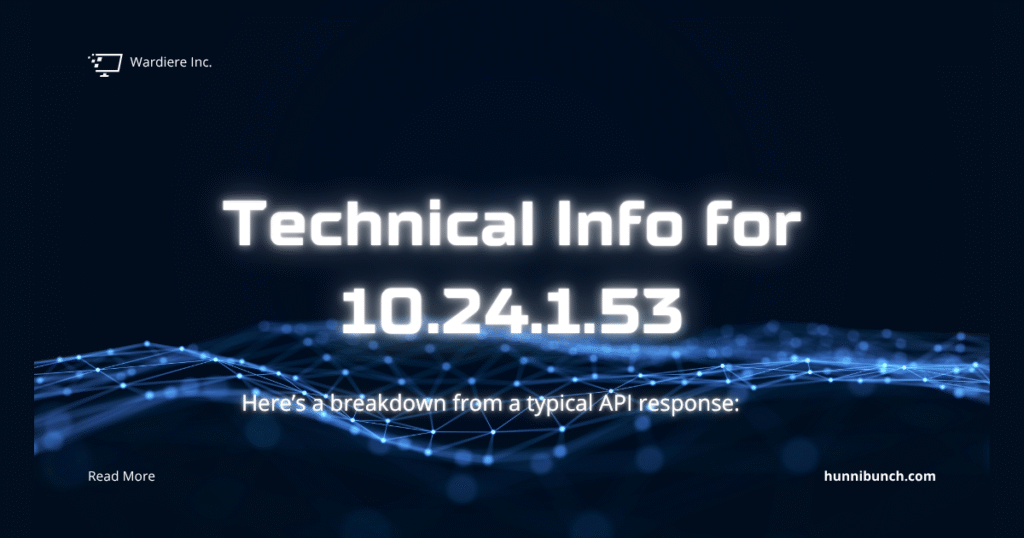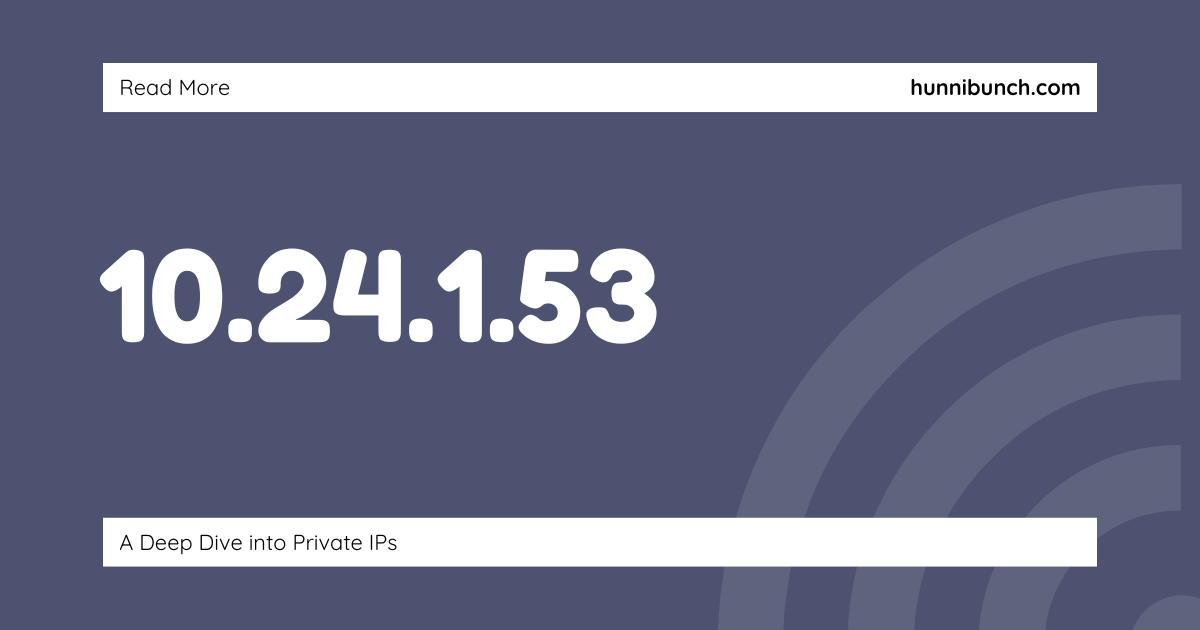The IP address 10.24.1.53 may look like just a string of numbers, but in the world of networking, it plays a silent yet critical role. While it doesn’t show up in public IP lookups or reveal a geographical location, this private IP is a backbone component in countless local area networks (LANs) used in homes, offices, and secure systems around the globe.
In this article, we’ll unpack everything you need to know about 10.24.1.53—what it is, how it functions, why it’s private, and why it matters for digital privacy and network security.
What Is 10.24.1.53?
10.24.1.53 is part of the IPv4 private address range defined by RFC 1918. It belongs to the block:
- 10.0.0.0 – 10.255.255.255 (10.0.0.0/8)
This range is exclusively reserved for use within private networks. It cannot be accessed or routed through the public internet. Devices using this address are often assigned IPs dynamically by local routers via DHCP (Dynamic Host Configuration Protocol).
Typical use cases include:
- Home Wi-Fi networks
- Office intranets
- VPN tunnels
- IoT device communication
Why 10.24.1.53 Won’t Show Location Details?

Private IP addresses like 10.24.1.53 don’t provide geographic location data. If you run this IP through a lookup service like IP2Location, you’ll get a result like this:
| Field | Value |
| IP Address | 10.24.1.53 |
| Country | – |
| Region | – |
| City | – |
| ISP | Private IP Address (LAN) |
| Elevation | 0m |
| Usage Type | Reserved |
| Address Type | Unicast |
| Fraud Score | 0 |
This is completely normal. Since it’s not meant to be public-facing, services can’t assign it to a region or track it across the web.
IP Lookup and 10.24.1.53

Using popular tools like IP2Location, ipinfo.io, or WHOIS, you’ll only get blank data or a message indicating the IP is reserved.
To truly understand how and where this IP is used, you’d need:
- Access to the local network router
- DHCP lease tables
- Internal device logs
Is 10.24.1.53 a Proxy?

Short answer: No.
Many wonder if this IP is acting as a proxy or some kind of cloaking mechanism. However, according to IP2Proxy:
- No proxy detected
- No VPN
- No TOR
- Not a bot or crawler
This confirms that 10.24.1.53 is safe, trustworthy, and simply part of your local setup.
Technical Info for 10.24.1.53

Here’s a breakdown from a typical API response:
| Field | Value |
| Country Name | – |
| Region Name | – |
| City Name | – |
| ISP | Private IP Address LAN |
| Domain | – |
| ASN | – |
| Net Speed | – |
| Elevation | 0 |
| Proxy Detected | No |
| Fraud Score | 0 |
This confirms once again that it’s internal-use only.
How to Use Slack, Reddit, or Telegram Bots for 10.24.1.53?

Want to get quick data about private IPs like 10.24.1.53? Try these bots:
| Platform | Command |
| Slack | /ip2location 10.24.1.53 |
| u/ip2location_bot 10.24.1.53 | |
| Telegram | ip2location 10.24.1.53 |
They use IP2Location APIs to fetch any available metadata (limited in this case due to the private nature).
Query 10.24.1.53 via API
For developers and network administrators, automate IP checks with:
curl “https://api.ip2location.io?key=YOUR_API_KEY&ip=10.24.1.53&format=json”
Even if the data returned is minimal, the structure is ideal for logging or alerts.
10.24.1.53 and Network Privacy
Why is this IP important for privacy?
- Cannot be accessed from outside the network
- Used only within LANs
- Not indexed, scanned, or geolocated
By staying internal, it helps protect your devices from unsolicited external traffic, brute force scans, or data leaks.
Can it Be Traced?
Not over the internet.
However, within your home or office, you can trace it using:
- traceroute 10.24.1.53
- Router logs
- Device admin tools (like ipconfig or ifconfig)
This will help you identify which device is assigned to this IP.
What If 10.24.1.53 Appears on Logs?

Don’t panic. It’s not an attacker.
Seeing 10.24.1.53 in logs means:
- A device on your internal network used or is using that IP
- It could be your phone, laptop, smart TV, or printer
Unless the traffic seems abnormal, it’s usually routine.
Public vs Private IP: Quick Guide
| Feature | Public IP | 10.24.1.53 (Private IP) |
| Globally Unique | Yes | No |
| Shows Location | Yes | No |
| Internet Visibility | Yes | No |
| Assigned By | ISP | Router |
| Security Level | Lower | Higher |
This highlights the built-in safety of private IPs.
Why You Should Know Your Private IP

Understanding addresses like 10.24.1.53 helps you:
- Debug connectivity issues
- Identify devices on your network
- Manage bandwidth or firewall rules
- Monitor security
You can find it using:
- ipconfig (Windows)
- ifconfig / ip a (Linux)
- System Preferences > Network (macOS)
IP2Location Demo Account Benefits
If you’re exploring IP data regularly, try a free IP2Location demo. It gives:
- 200 lookups/day
- IPv4 + IPv6 support
- Frequent database updates
Great for learning or lightweight analysis.
More Ways to Explore IPs Like 10.24.1.53
Even though it’s private, you can:
- Analyze DHCP tables
- Explore firewall logs
- Set up network monitoring tools
- Use Nmap or Wireshark for local scanning
It’s all part of smarter network management.
Final Thoughts
10.24.1.53 may never trend on the internet, but it quietly plays a vital role in your daily digital life. It enables internal communication, powers smart home setups, and reinforces privacy by staying off the public web. It’s not a threat. It’s not a mystery. It’s a trusted building block of modern networking. Whether you’re a developer, IT admin, or curious learner, knowing your private IPs is your first step toward mastering digital security.
FAQs
Q: Can someone hack me through this IP?
A: No, not from outside your private network.
Q: Why is my device using 10.24.1.53?
A: It was assigned automatically by your router.
Q: Does this IP reveal my location?
A: No. It hides location completely.
Q: Is it used in business networks too?
A: Absolutely. It’s common in corporate LANs and secure systems.
Read More: This Blog Will Show You About the New Digital Technology in Thailand | Nai Taiyari.com | Qoruv.com Pioneering Firm in Marketing Intelligence | Tallyman Axis | PNP CODA



